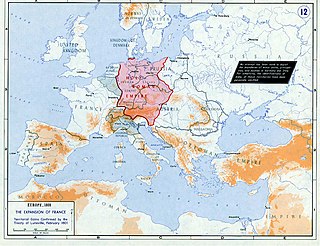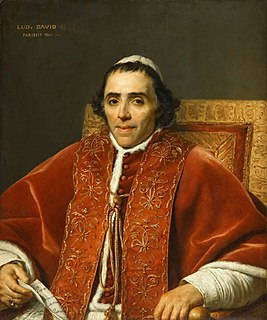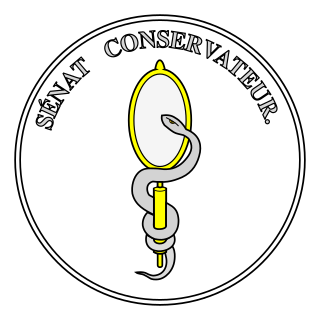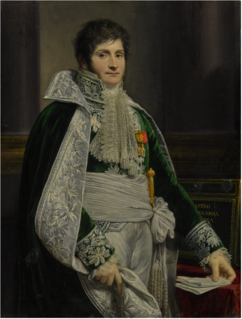
Ferdinando, comte Marescalchi (26 February 1754, Bologna - 22 June 1816, Milan) was an Italian diplomat and politician.

Ferdinando, comte Marescalchi (26 February 1754, Bologna - 22 June 1816, Milan) was an Italian diplomat and politician.
He was from an old noble family which had originated in Vicenza. He studied law at the University of Bologna, became a magistrate and became a hereditary member of the senate which governed Bologna. When the French invaded Italy, he led the faction which openly declared in their favour and came to the attention of Bonaparte, who placed much trust and confidence in him. He was a strong supporter of the political reform of 1796 and when the Cispadane Republic was formed that year he became part of its executive directory. The Cisalpine Republic sent him to Vienna as its plenipotentiary in 1799, but he was only able to gain a single audience with Francis I of Austria. He then became plenipotentiary to the Second Congress of Rastatt (9 December 1797 to 23 April 1799).

On his return he was elected director-president in March 1799, but soon the Russo-Austrian invasion forced him and his colleagues to flee to France until they were able to return after the Battle of Marengo. In July 1800 he was made the Cisalpine representative to Paris. He took part in the 1801-02 Consulte de Lyon in the former chapel of the Jesuit college of the trinity (now the chapel of the Lycée Ampère on rue de la Bourse). At first it suggested electing Francesco Melzi d'Eril, then Antonio Aldini, as president, but they both declined. Talleyrand then intervened and suggested that the Italians elect Bonaparte himself, due to the presence of French troops in Italy and the reluctance of the other Italian states to recognise the Cisalpine Republic - this suggestion was accepted, with Marescalchi's full support.
Napoleon made his acceptance speech in Italian on 26 January 1802 (he had effectively arrived in France aged 9 speaking Italian and no French and always spoke French with an accent on certain words and used several unusual spellings [1] ) and in it changed the Cisalpine Republic's name to the Italian Republic. This led to riotous applause. Bonaparte then chose Melzi d'Eril as vice-president, to reside in Milan.
Marescalchi lived in Paris as the Republic's foreign minister from 1802 to 1805. He was strongly supported in his work by Bernier, bishop of Orléans, who with Giovanni Battista Caprara co-organised the Concordat between Rome and Italian Republic, signed in Paris on 9 September 1803. Marescalchi also assisted in the coronation of Napoleon I on 2 December 1804.
After the 'acte de la consulta', which made Napoleon king of Italy, Marescalchi became his representative in France, but with limited autonomy in Italy. He and Emmanuel Crétet signed a Franco-Italian trade treaty on 20 June 1808. He rented Hôtel de Massa as his Paris residence and held many festivities there, making it a key meeting point for the nobility of the First French Empire and launching the fashion for masked or fancy-dress balls. In 1809 he received the emperor himself before setting off for the Battle of Wagram.
When the Grand Orient of Italy was set up on 20 June 1805, Marescalchi was its grand conservator and prince Eugène de Beauharnais its grandmaster. Napoleon also made Marescalchi a count of the Kingdom of Italy in December 1810 (by letters patent of 12 April 1809), grand chancellor of the Order of the Iron Crown and a member of all the Napoleonic orders. He was also member of the electoral college of Reno.
After Napoleon's abdication, Marie-Louise of Austria made Marescalchi governor of the Grand Duchy of Parma and Piacenza. He was also the Austrian emperor's plenipotentiary at Modena, where he died on 22 June 1816.
He also published sonnets and 'canzoni'.

The Treaty of Lunéville was signed in the Treaty House of Lunéville on 9 February 1801. The signatory parties were the French Republic and Emperor Francis II, who signed on his own behalf as ruler of the hereditary domains of the House of Austria and on behalf of the Holy Roman Empire. The signatories were Joseph Bonaparte and Count Ludwig von Cobenzl, the Austrian foreign minister. The treaty formally ended Austrian and Imperial participation in the War of the Second Coalition and the French Revolutionary Wars.

Joachim Murat was a French military commander and statesman who served during the French Revolutionary Wars and Napoleonic Wars. Under the French Empire he received the military titles of Marshal of the Empire and Admiral of France; he was also the 1st Prince Murat, Grand Duke of Berg from 1806 to 1808 and King of Naples as Joachim-Napoleon from 1808 to 1815. He was the brother-in-law of Emperor Napoleon I, who characterised him as exceptionally brave in the face of the enemy, a weakling when he was on his own, a braggart dressed in gold and feathers, continually escaping as by miracle and admired by the Cossacks for his bravery.

The Cisalpine Republic was a sister republic of France in Northern Italy that lasted from 1797 to 1802.

The Italian Republic was a short-lived (1802–1805) republic located in Northern Italy. Napoleon Bonaparte served as president and its capital was Milan.

The Kingdom of Italy was a kingdom in Northern Italy in personal union with France under Napoleon I. It was fully influenced by revolutionary France and ended with Napoleon's defeat and fall. Its government was assumed by Napoleon as King of Italy and the viceroyalty delegated to his step-son Eugène de Beauharnais. It covered Savoy and the modern provinces of Lombardy, Veneto, Emilia-Romagna, Friuli Venezia Giulia, Trentino, South Tyrol, and Marche. Napoleon I also ruled the rest of northern and central Italy in the form of Nice, Aosta, Piedmont, Liguria, Tuscany, Umbria, and Lazio, but directly as part of the French Empire, rather than as part of a vassal state.

The 1799–1800 papal conclave followed the death of Pope Pius VI on August 29, 1799, and led to the selection of Cardinal Barnaba Niccolò Maria Luigi Chiaramonti, who took the name Pius VII, on March 14, 1800. This conclave was held in Venice and was the last to take place outside Rome. This period was marked by uncertainty for the Pope and the Roman Catholic Church following the invasion of the Papal States and abduction of Pius VI under the French Directory.

Maria Anna Elisa Bonaparte Baciocchi Levoy was an imperial French princess and sister of Napoleon Bonaparte. She was Princess of Lucca and Piombino (1805-1814), Grand Duchess of Tuscany (1809-1814) and Countess of Compignano by appointment of her brother.

A sister republic was a republic established by French armies or by local revolutionaries and assisted by the First French Republic during the French Revolutionary Wars. These republics, though nominally independent, relied heavily on France for protection, making them more akin to autonomous territories rather than independent states. This became particularly evident after the declaration of the French Empire, when several states were annexed, and the remaining turned into monarchies ruled by members of the Bonaparte family.

Giovanni Battista Caprara Montecuccoli was an Italian statesman and Cardinal and archbishop of Milan from 1802 to 1810. As a papal diplomat he served in the embassies in Cologne, Lausanne, and Vienna. As Legate of Pius VII in France, he implemented the Concordat of 1801, and negotiated with the Emperor Napoleon over the matter of appointments to the restored hierarchy in France. He crowned Napoleon as King of Italy in Milan in 1805.
The title of Conte di Magenta was created on 30 December 1619 for Don Luigi Melzi, of a Milanese patrician family. His descendant Gaspare, eighth Count, married Maria Teresa d'Eril, daughter and heiress of the Marchese de Fuente Sagrada, and their descendants adopted the name Melzi d'Eril. Francesco Melzi d'Eril, ninth Count, was made Vice-President of the Italian Republic under Napoleon Bonaparte in 1802, and Grand Chancellor of the Napoleonic Kingdom of Italy in 1805. On 20 December 1807 he was created Duca di Lodi by Napoleon in his capacity as King of Italy. The Duke was childless, and adopted as his heir his nephew Giovanni Francesco. On his death he was succeeded as tenth Count by his brother Luigi. The Emperor of Austria, as King of Lombardy–Venetia after the Congress of Vienna, recognised the comital title of Magenta in 1816, but did not recognise the Napoleonic dukedom of Lodi. However, Giovanni was given the title of Duca Melzi on 5 September 1818. His son Lodovico, twelfth Count of Magenta, reassumed the title of Duca di Lodi in 1859. The titles of Duca di Lodi and Conte di Magenta were recognised for his successors by ministerial decrees of the new Kingdom of united Italy dated 1890, 1913 and 1939. While there are still heirs to these titles, they were suppressed in 1947 along with all other Italian noble titles.

The Flags of Napoleonic Italy were the green, white and red tricolour flags and banners in use in Italy during the Napoleonic era, which lasted from 1796 to 1814. During this period, on 7 January 1797, the green, white and red tricolour was officially adopted for the first time as a national flag by a sovereign Italian state, the Cispadane Republic. This event is commemorated by the Tricolour Day.

Charles-Frédéric, comteReinhard was a Württembergian-born French diplomat, essayist, and politician who briefly served as the Consulate's Minister of Foreign Affairs in 1799. A Girondist during the early stages of the French Revolution, he was dispatched to several countries before and after his ministerial mandate. In 1806–1807, he was appointed Consul and Resident to Moldavia, and subsequently arrested by the Russian Empire for one year. Reinhard was promoted under the Bourbon Restoration governments, which he represented to the German Confederation, and continued his political career under the July Monarchy.

The Sénat conservateur was an advisory body established in France during the Consulate following the French Revolution. It was established in 1799 under the Constitution of the Year VIII following the Napoleon Bonaparte-led Coup of 18 Brumaire. It lasted until 1814 when Napoleon Bonaparte was overthrown and the Bourbon monarchy was restored. The Sénat was a key element in Napoleon's regime.

The First French Empire, officially the French Republic, then the French Empire after 1809, also known as Napoleonic France, was the empire ruled by Napoleon Bonaparte who established French hegemony over much of continental Europe at the beginning of the 19th century. It lasted from 18 May 1804 to 11 April 1814 and again briefly from 20 March 1815 to 7 July 1815.,

Achille Fontanelli was an Italian nationalist and Napoleonic general. Born into a low-ranking noble family, he took service with a pro-French Italian military unit in 1797. He was captured in 1799 but was repatriated in time to serve in the Marengo Campaign in 1800. He was promoted to general officer in 1804 and in the 1809 war he led an Italian division in several major battles. After serving as Minister of War to Eugène de Beauharnais, he was tapped to command a division in the 1813 campaign. After the collapse of Napoleon's empire in 1814, he took service with the Austrian Empire.

Claude Louis Petiet was a Commissioner of war in 1778, elected to the Council of Elders in 1795, and was appointed Minister of War on 8 February 1796. He was dismissed on 14 July 1797 by the French Directory of Paul Barras, Jean-François Reubell and Louis Marie de La Révellière-Lépeaux. Appointed to the State Council by Napoleon Bonaparte, he became steward of the army camp at Boulogne in 1805 and senator in 1806.

Francesco Melzi d'Eril, Duke of Lodi, Count of Magenta, was an Italian politician and patriot, serving as vice-president of the Napoleonic Italian Republic (1802–1805). He was a consistent supporter of the Italian unification ideals that would lead to the Italian Risorgimento shortly after his death.

The Consulte de Lyon or consulte de la république cisalpine was an extraordinary meeting in the former chapel of the Jesuit college of the Trinity in Lyon during the French Consulate. It was held from 11–26 January 1802 and converted the Cisalpine Republic into the Italian Republic, with Napoleon Bonaparte as its president.

Stefano Bonsignori or Bonsignore O.SS.C.A. was an Italian cleric, bishop and theologian. Napoleon I appointed him patriarch of Venice, but this appointment was not confirmed by the Holy See.
Gian Galeazzo Serbelloni was a Milanese nobleman, notable as president of the founding Directory of the Cisalpine Republic and as preceptor to the Milanese poet Giuseppe Parini.